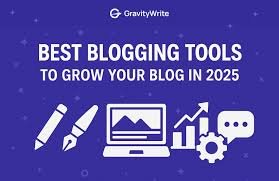In 2025, blogging is no longer just about writing—it’s about optimizing, automating, and scaling your content production to meet the demands of an ever-expanding audience. With the right tools, bloggers can streamline processes, improve content quality, and grow their online presence. Whether you’re a beginner or a seasoned blogger, leveraging advanced software can help you stay ahead of the competition. In this article, we’ll explore the best blogging software tools that will help you grow and automate your content creation in 2025.
1. WordPress: The Ultimate Content Management System
WordPress continues to dominate as the most popular blogging platform in 2025, offering unparalleled customization, flexibility, and scalability. It comes with a wide range of themes, plugins, and integrations that allow bloggers to create fully functional websites, manage content effortlessly, and improve SEO.
Why it’s important:
WordPress powers over 40% of all websites, thanks to its ease of use and powerful features. The platform enables bloggers to manage posts, optimize SEO, and design their websites with minimal coding. With its vast community and support, WordPress is the perfect tool for both beginners and experts to grow their blog.
2. Grammarly: Enhance Content Quality with AI
Grammarly has become an indispensable tool for bloggers looking to produce error-free, high-quality content. This AI-powered writing assistant checks for grammar, punctuation, style, and tone, ensuring that every post is clear, concise, and professional. Additionally, Grammarly’s readability analysis ensures your content resonates with readers.
Why it’s important:
Grammarly reduces the time spent on editing and proofreading, helping bloggers improve writing quality faster. With real-time suggestions, bloggers can create polished content that engages readers while minimizing errors, ultimately increasing their credibility and authority.
3. Yoast SEO: Master On-Page SEO
Yoast SEO is a WordPress plugin that helps bloggers optimize their posts for search engines. By offering real-time SEO feedback, Yoast helps you improve keyword usage, meta descriptions, readability, and more. It also includes features like internal linking suggestions and focus keyword analysis, ensuring that your content is both SEO-friendly and user-friendly.
Why it’s important:
SEO is crucial for driving organic traffic to your blog. Yoast SEO ensures that your content ranks higher on Google and other search engines by optimizing it for both search algorithms and human readers. As SEO continues to evolve, Yoast SEO remains an essential tool for bloggers looking to boost visibility.
4. Canva: Create Stunning Visuals for Your Blog
Visual content is essential for engaging readers, and Canva is one of the best design tools for bloggers in 2025. With its easy-to-use interface and vast library of templates, images, and fonts, Canva allows you to design blog post covers, social media graphics, infographics, and more without the need for advanced design skills.
Why it’s important:
High-quality visuals can significantly improve engagement and shareability. Canva’s design capabilities make it easy for bloggers to create professional, visually appealing content, enhancing their brand image and increasing time spent on site by readers.
5. Trello: Organize and Automate Content Planning
Trello is a project management tool that helps bloggers organize and automate their content creation process. With Trello, you can create content calendars, set deadlines, and track content progress. You can also collaborate with teams, making it ideal for bloggers who work with guest writers or other contributors.
Why it’s important:
Efficient content management is crucial for consistency. Trello helps bloggers stay organized, ensuring that posts are planned, written, and published on time. Its collaborative features also streamline the workflow for multi-author blogs, helping teams manage content more effectively.
6. Hootsuite: Automate Social Media Management
Hootsuite is a social media management tool that enables bloggers to schedule and automate social media posts across multiple platforms like Facebook, Twitter, Instagram, and LinkedIn. It also allows you to track performance, monitor engagement, and optimize your social media strategy.
Why it’s important:
Social media is an essential channel for driving traffic to your blog. Hootsuite’s automation features save bloggers time by scheduling posts in advance, ensuring that content is shared consistently without manual effort. With Hootsuite, bloggers can engage with their audience and promote content more effectively.
7. Mailchimp: Automate Email Marketing
Mailchimp is one of the leading email marketing platforms that allows bloggers to build email lists, create automated campaigns, and track performance. Bloggers can use Mailchimp to send personalized emails, newsletters, and product recommendations, all while managing subscriber lists with ease.
Why it’s important:
Email marketing continues to be one of the most effective ways to drive traffic and sales. With Mailchimp, bloggers can automate their email campaigns, build relationships with their readers, and boost engagement, all while reducing the time spent on manual email outreach.
8. CoSchedule: Optimize Your Content Distribution
CoSchedule is an all-in-one marketing calendar and content management tool that helps bloggers schedule, promote, and analyze their content. It integrates with WordPress and social media platforms to provide a seamless workflow for managing blog posts, social shares, and emails in one place.
Why it’s important:
CoSchedule streamlines the content distribution process, ensuring that blog posts are shared at the right time across the right channels. By automating this process, bloggers can reach a larger audience and maintain consistent promotion of their content.
9. Zapier: Automate Repetitive Tasks
Zapier allows bloggers to automate repetitive tasks by connecting different apps and workflows. For example, you can set up a “Zap” to automatically share new blog posts on social media or save your blog comments to a Google Sheets document. It works with thousands of apps, including WordPress, Google Drive, Slack, and more.
Why it’s important:
Automation is key to scaling your blogging efforts. Zapier saves bloggers valuable time by automating routine tasks and integrating different platforms. This increases efficiency and allows bloggers to focus on higher-value activities like content creation and audience engagement.
10. Google Analytics: Track and Measure Performance
Google Analytics provides in-depth insights into how visitors interact with your blog. It tracks website traffic, user behavior, conversion rates, and more, helping bloggers understand their audience and improve content strategy.
Why it’s important:
Data-driven decisions are crucial for growth. By regularly analyzing Google Analytics, bloggers can identify what content performs best, which traffic sources bring the most visitors, and how to optimize their strategies for better results.
Conclusion
In 2025, blogging has become more competitive than ever, and leveraging the best blogging software tools is essential for staying ahead. From SEO and content creation to automation and social media management, these tools help streamline workflows, improve content quality, and ultimately drive traffic and revenue. By integrating these tools into your blogging strategy, you can work smarter, not harder, and maximize the potential of your content.

